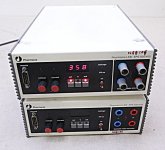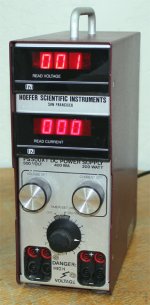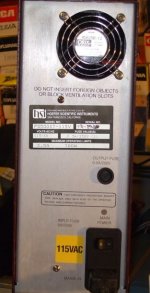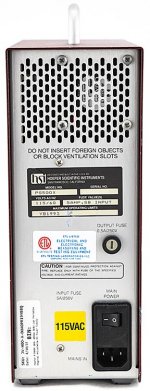Here we go.
$99, 500V, 400 mA, digital readout, analog V and I knobs, 9.5 lbs, reasonably compact 10" W x 4" H x 17" D (especially if 2 or 3 are stacked ), and looks like it could include a ground fault interrupter (leakage)
(and remote? If it can be programmed for V and I with readbacks, it might be use-able for a PC tube curve tracer?)
There's even one on sale (and working) for just $50! (in Calif.)
I'd like to see what is in these things. With heatsinks making up the case itself and 10 lbs, it could be a linear design, but more likely a HF switcher.
I think I'll get one just to find out.
Pharmacia I believe is a subsidiary of Pfizer, though it may have long since been shut down.
It looks like the Pharmacia/LKB electrophoresis stuff started with LKB, a Swedish laboratory equipment outfit dating back to the 1880s, with a Nobel prize for the invention of electrophoresis even.
Pharmacia bought LKB in the 1980s, and UpJohn bought Pharmacia, then Pfizer bought Pharmacia in the 90s. No sign of electrophoresis equipment on the Pfizer site. No Pharmacia or LKB sites at all relevant to electrophoresis. No manuals around for the LKB equipment, except a Russian phony site that will trash your computer and steal your passwords.
Looks like Amersham (something about that name) acquired the biotech business from Pharmacia/UpJohn, then that was bought up by GE Healthcare. No sign of electrophoresis at GE Healthcare now. Gone....
Probably why the Pharmacia/LKB equipment is so cheap on Ebay now. Shuffled out of existence. Without a trace. The INVENTORS of electrophoresis completely lost.
I ordered one of the Pharmacia LKB EPS 500/400 power supplies, and I will post pics and a design analysis when I get it here. I like that it has no fan, it could be used for bench use or for powering an amplifier.
I also ordered a Hoefer PS 500X electrophoresis power supply with similar specifications. Only 7 lbs. Another early electrophoresis outfit bought up by Amersham. I will post pics etc on that too.
One little note of interest:
(Oh, I got that -not working- $120 Xantrex XHR in and working perfectly within 15 minutes!)
The Xantrex supplies have a shunt Mosfet across their output (but ahead of the current sensing resistor) which allows them to reduce the charge on the final smoothing capacitor (that eliminates switching noise) quickly, whenever the current limit is exceeded (or for OV conditions). They have sub 1 millisecond response time! (compared to those 60Hz Triac phase control TANKS that respond in seconds after your expensive tubes have melted.) This technique could be added to these other cheap (HF switching type) supplies with some clever circuit analysis and design. I will look into that with the LKB and Hoefer units in the future.
Pharmacia bought LKB in the 1980s, and UpJohn bought Pharmacia, then Pfizer bought Pharmacia in the 90s. No sign of electrophoresis equipment on the Pfizer site. No Pharmacia or LKB sites at all relevant to electrophoresis. No manuals around for the LKB equipment, except a Russian phony site that will trash your computer and steal your passwords.
Looks like Amersham (something about that name) acquired the biotech business from Pharmacia/UpJohn, then that was bought up by GE Healthcare. No sign of electrophoresis at GE Healthcare now. Gone....
Probably why the Pharmacia/LKB equipment is so cheap on Ebay now. Shuffled out of existence. Without a trace. The INVENTORS of electrophoresis completely lost.
I ordered one of the Pharmacia LKB EPS 500/400 power supplies, and I will post pics and a design analysis when I get it here. I like that it has no fan, it could be used for bench use or for powering an amplifier.
I also ordered a Hoefer PS 500X electrophoresis power supply with similar specifications. Only 7 lbs. Another early electrophoresis outfit bought up by Amersham. I will post pics etc on that too.
One little note of interest:
(Oh, I got that -not working- $120 Xantrex XHR in and working perfectly within 15 minutes!)
The Xantrex supplies have a shunt Mosfet across their output (but ahead of the current sensing resistor) which allows them to reduce the charge on the final smoothing capacitor (that eliminates switching noise) quickly, whenever the current limit is exceeded (or for OV conditions). They have sub 1 millisecond response time! (compared to those 60Hz Triac phase control TANKS that respond in seconds after your expensive tubes have melted.) This technique could be added to these other cheap (HF switching type) supplies with some clever circuit analysis and design. I will look into that with the LKB and Hoefer units in the future.
Last edited:
Looks like Amersham (something about that name) acquired the biotech business from Pharmacia/UpJohn, then that was bought up by GE Healthcare. No sign of electrophoresis at GE Healthcare now. Gone....
This was the link I COULD NOT FIND! I knew that Amersham went by Amersham Pharmacia before being acquired by GE for a while but couldn't find out how they were linked. GE acquired Amersham for the Akta line of FPLC devices, which GE still owns and produces (they are industry standard in my field and DAMN good); everything else from Amersham Pharmacia was just gravy.
GE still sells the EPS lines of power supplies for electrophoresis. You can find the EPS 301, EPS 601 and EPS 3501 XL on the GE Lifesciences page (buried in menus or via a Google Search). GE is only a minor player in the electrophoresis power supply space. Most of the ones I have see have come from ThermoFisher, LifeTech/Invitrogen (now a part of ThermoFisher), Owl, Bio-Rad, etc. If I had to pick one, I would say Bio-Rad seems to dominate the space, followed by this funky looking Invitrogen/Novex model which a large number of labs have.
I got the Pharmacia LKB EPS 500/400 power supply unit in, and also the Hoefer PS500XT unit. Both electrophoresis type supplies. ( $64 for the Pharmacia and $105 for the Hoefer, plus shipping)
I'll be posting a thread on these soon on the Tubes-Valves Forum (and then the moderator will probably move it back here again!)
Here are some measurements.
Pharmacia LKB EPS 500/400 unit:
Requires less than 1 mA load to activate (ie, has a no load safety shut-down).
Also has a leakage indicator and shut-down. (a ground fault interrupter safety, detects stray current going to ground, like used in modern kitchen outlets, super safe)
500V, 400 mA, 200 Watt max specs.
Weight 9 Lbs.
Dimensions: 3.75" H x 8.625" W x 16" D (including heatsink and knobs)
(Height not including rubber feet on bottom, another .25") Uses up bench space, but could stack multiple units.
Power switch on the back is very hard to switch. Does have an easy standby switch on the front panel. V and I knobs are small and un-comfortable to use.
Only one digital readout meter, button switchable between actual Vout, actual Iout, V knob setting, and I knob setting. (the extra knob setting readouts are nice, but it definitely needs an extra Vout meter operating 100% of the time)
Has current limiting, with LED V and I mode indicators. Current limiting just turns off the converter, somewhat slow for the Vout to decay.
Euro style deep recessed mini banana plug output terminals (electrophoresis style)
Operates at 28.5 KHz using a flyback converter design using Philips TDA1060 controller chip with a heatsinked TO-5 driver transistor. Single switching transistor, TO-3, (probably bipolar) Heatsinked on the back, no fan. Two resistors on PC board getting rather hot (board browned around the 3 Watter)
Electrical OUTPUT NOISE:
20 Vp-p 60Hz (full load, 500Vout)
4 Vp-p HF switching noise (full load, 28.5 KHz)
Common mode noise: 8 Vp-p CM at 120 Hz, 1 Vp-p CM at HF (28.5 KHz)
Has no line input line filter (60 Hz 120VAC) except two small AC caps to ground. Just rectifiers into 2 x 680 uF DC Caps
Has no output HF filter except 4 x 22uF DC Caps in series.
POWER CONSUMPTION: 11 Watts no load, 33 Watts with 15W load, 218 Watts with 187.3 Watt load (delta = 30.7 Watts loss)
Hoefer PS500XT unit:
No safety features. ( just recessed standard banana plug electrophoresis jacks)
500V, 400 mA, 200 Watt max. specs
Weight 6 Lbs. Has easy carry handle on top.
Dimensions: 10.75" H (+ 1.25" for handle and rubber feet), 4.125" W x 10.125" D (including knobs) Minimal bench space used, nice. Easy portable.
Power switch on back, and also on the front (rocker for PS500X, timer knob for PS500XT) No easy standby switch. The 500XT timer knob version does NOT have a definite OFF detent!! Even rotates around past the off position to ON again! (dangerous!!) V and I knobs are big, comfortable to use.
Two LED digital meters, actual Vout up top, and actual Iout below that)
The I knob sets current limiting, but there is NO LED indicator when running in current limit mode. (annoying) And the current limiting just turns off the converter, it takes 10 seconds!! for the Vout to decay without additional loading.
Recessed standard banana jacks for output.
Operates at 74 KHz half bridge converter (effectively 148 KHZ charge pulses) using 4 IRF830 Mosfets (parallel'd pairs) and using a TL594CN controller chip with an added dual gate driver chip. Has two 20 Watt!! snubber resistors that run HOT. These are off the PC board enough to avoid a brown board. Early units had no fan, just perforated vents on back. Some of these early units can be seen with a fan added as a mod, on Ebay!!! Later units have a round 12 VDC fan on back designed in. And noisy as Hell. (I modded the unit here to run with just 6 VDC for the fan, and it is now quiet and stays cool enough.)
Electrical OUTPUT NOISE:
250 mVp-p 120 Hz noise (400 mA load)
125 mVp-p HF 143 KHz noise (400 mA load)
Common mode noise: 4 Vp-p 120 Hz, 2 to 2.7 Vp-p (load) HF 143 KHz noise.
Has no line input filter (120 VAC, 60 Hz) except two small AC caps to ground. Just rectifiers into 2x 680 uF DC Caps.
Has no output HF filter except 3x 220uF 200VDC Caps in series.
POWER CONSUMPTION: 12.5 Watt NO load with a High Vout setting, 6.25 Watts no load at 0 Vout setting, 214 Watts with 166 Watt load (delta = 48 Watt loss)
SUMMERY:
The Pharmacia/LKB unit needs a 2nd digital Vout meter, that is always operating. There is room on the front panel for that addition if the two extra output terminals are eliminated. Unit runs quiet, could be used as a stationary power supply for a tube amplifier, IF the Electrical NOISE problems are fixed.
The Hoefer unit needs added LED V and I mode indicators (at least an I mode LED) added. No provision for obtaining this signal from the controller chip unfortunately. May be able to tap off a crude I mode indicator from the LM358P OP Amp measuring the output current for the controller. (unit does current limit according to the I knob setting, you just can't visually tell when)
The easy V and I knob controls are well suited for bench top use. But needs an easy standby switch added for safety. The fan quieting mod is essential!! I changed the stupid timer/knob to a toggle switch with a BIG insulated toggle handle. (no more need to read the manual to figure out how to turn it off in an emergency!!)
Both units need added line input filtering AND HF output filtering. ESPECIALLY the Pharmacia LKB unit!! Common mode HF output filtering too. Most bench switching supplies use a full C - L - C - CM choke filter on the output. I've noticed that Xantrex XHR supplies also have a shunt Mosfet across the output to pull the Vout down quickly (1 mSec) when either the Current Limit or Over Voltage modes activate. This -could- be added to these units IF an I limit signal is available. Especially useful after adding more filter Caps, since those will further delay the output voltage decay. Might save some tubes from melting down occasionally.
..
I'll be posting a thread on these soon on the Tubes-Valves Forum (and then the moderator will probably move it back here again!)
Here are some measurements.
Pharmacia LKB EPS 500/400 unit:
Requires less than 1 mA load to activate (ie, has a no load safety shut-down).
Also has a leakage indicator and shut-down. (a ground fault interrupter safety, detects stray current going to ground, like used in modern kitchen outlets, super safe)
500V, 400 mA, 200 Watt max specs.
Weight 9 Lbs.
Dimensions: 3.75" H x 8.625" W x 16" D (including heatsink and knobs)
(Height not including rubber feet on bottom, another .25") Uses up bench space, but could stack multiple units.
Power switch on the back is very hard to switch. Does have an easy standby switch on the front panel. V and I knobs are small and un-comfortable to use.
Only one digital readout meter, button switchable between actual Vout, actual Iout, V knob setting, and I knob setting. (the extra knob setting readouts are nice, but it definitely needs an extra Vout meter operating 100% of the time)
Has current limiting, with LED V and I mode indicators. Current limiting just turns off the converter, somewhat slow for the Vout to decay.
Euro style deep recessed mini banana plug output terminals (electrophoresis style)
Operates at 28.5 KHz using a flyback converter design using Philips TDA1060 controller chip with a heatsinked TO-5 driver transistor. Single switching transistor, TO-3, (probably bipolar) Heatsinked on the back, no fan. Two resistors on PC board getting rather hot (board browned around the 3 Watter)
Electrical OUTPUT NOISE:
20 Vp-p 60Hz (full load, 500Vout)
4 Vp-p HF switching noise (full load, 28.5 KHz)
Common mode noise: 8 Vp-p CM at 120 Hz, 1 Vp-p CM at HF (28.5 KHz)
Has no line input line filter (60 Hz 120VAC) except two small AC caps to ground. Just rectifiers into 2 x 680 uF DC Caps
Has no output HF filter except 4 x 22uF DC Caps in series.
POWER CONSUMPTION: 11 Watts no load, 33 Watts with 15W load, 218 Watts with 187.3 Watt load (delta = 30.7 Watts loss)
Hoefer PS500XT unit:
No safety features. ( just recessed standard banana plug electrophoresis jacks)
500V, 400 mA, 200 Watt max. specs
Weight 6 Lbs. Has easy carry handle on top.
Dimensions: 10.75" H (+ 1.25" for handle and rubber feet), 4.125" W x 10.125" D (including knobs) Minimal bench space used, nice. Easy portable.
Power switch on back, and also on the front (rocker for PS500X, timer knob for PS500XT) No easy standby switch. The 500XT timer knob version does NOT have a definite OFF detent!! Even rotates around past the off position to ON again! (dangerous!!) V and I knobs are big, comfortable to use.
Two LED digital meters, actual Vout up top, and actual Iout below that)
The I knob sets current limiting, but there is NO LED indicator when running in current limit mode. (annoying) And the current limiting just turns off the converter, it takes 10 seconds!! for the Vout to decay without additional loading.
Recessed standard banana jacks for output.
Operates at 74 KHz half bridge converter (effectively 148 KHZ charge pulses) using 4 IRF830 Mosfets (parallel'd pairs) and using a TL594CN controller chip with an added dual gate driver chip. Has two 20 Watt!! snubber resistors that run HOT. These are off the PC board enough to avoid a brown board. Early units had no fan, just perforated vents on back. Some of these early units can be seen with a fan added as a mod, on Ebay!!! Later units have a round 12 VDC fan on back designed in. And noisy as Hell. (I modded the unit here to run with just 6 VDC for the fan, and it is now quiet and stays cool enough.)
Electrical OUTPUT NOISE:
250 mVp-p 120 Hz noise (400 mA load)
125 mVp-p HF 143 KHz noise (400 mA load)
Common mode noise: 4 Vp-p 120 Hz, 2 to 2.7 Vp-p (load) HF 143 KHz noise.
Has no line input filter (120 VAC, 60 Hz) except two small AC caps to ground. Just rectifiers into 2x 680 uF DC Caps.
Has no output HF filter except 3x 220uF 200VDC Caps in series.
POWER CONSUMPTION: 12.5 Watt NO load with a High Vout setting, 6.25 Watts no load at 0 Vout setting, 214 Watts with 166 Watt load (delta = 48 Watt loss)
SUMMERY:
The Pharmacia/LKB unit needs a 2nd digital Vout meter, that is always operating. There is room on the front panel for that addition if the two extra output terminals are eliminated. Unit runs quiet, could be used as a stationary power supply for a tube amplifier, IF the Electrical NOISE problems are fixed.
The Hoefer unit needs added LED V and I mode indicators (at least an I mode LED) added. No provision for obtaining this signal from the controller chip unfortunately. May be able to tap off a crude I mode indicator from the LM358P OP Amp measuring the output current for the controller. (unit does current limit according to the I knob setting, you just can't visually tell when)
The easy V and I knob controls are well suited for bench top use. But needs an easy standby switch added for safety. The fan quieting mod is essential!! I changed the stupid timer/knob to a toggle switch with a BIG insulated toggle handle. (no more need to read the manual to figure out how to turn it off in an emergency!!)
Both units need added line input filtering AND HF output filtering. ESPECIALLY the Pharmacia LKB unit!! Common mode HF output filtering too. Most bench switching supplies use a full C - L - C - CM choke filter on the output. I've noticed that Xantrex XHR supplies also have a shunt Mosfet across the output to pull the Vout down quickly (1 mSec) when either the Current Limit or Over Voltage modes activate. This -could- be added to these units IF an I limit signal is available. Especially useful after adding more filter Caps, since those will further delay the output voltage decay. Might save some tubes from melting down occasionally.
..
Attachments
Last edited:
Wow! George that is cool. How come you guys back then chose to use a digital meter for current?
When I started working at Motorola I worked as a tech TUNING the individual stages of the HT220 walkie talkie. The individual frequency triplers in the transmitter are tuned for maximum current. A Weston 911 analog meter with a big scale on it was the preferred choice. I bought one at the equipment auction when they closed down that product line and scrapped all the test equipment. I still have it and use it often.
The power supplies I talked about were used in the final TEST stations for the MX-300 radios. There was no tuning involved. The radios were all modular. If it didn't work the tech swapped modules until it did. The radios were tested to a performance spec and it passed, or it didn't. A single reading accurate to a tenth of a milliamp was needed, and every station had to read exactly the same. I had a dummy radio with a bank of resistors in it for checking test stations. The digital meters worked out well after we put the copper screen in front of them to keep the RF out!
Ask George - he has the HP variety that takes eons to make up its mind that there's a short on its output...
It is basically a switcher that operates at a 120 Hz switching freq. The control loop must be far slower than that to maintain stability especially since the supply has an internal CLC filter at its output. Each cap is 500uF. Regardless of what the control loop does, 1000uF charged to 600 volts of so will fix the short long before the control loop even knows it's there. It will also convince you to pay attention to those voltage ratings on resistors. A small 1/4 metal film resistor fed by the HP will explode when the downstream electrolytic shorts because the blonde turning the voltage knob got a little carried away. The remains of the cap and resistor were never found, even when cleaning out the house prior to moving out. There was however still some fragments of another larger electrolytic embedded in the ceiling, but that's from a different "blonde moment."
- Status
- Not open for further replies.



